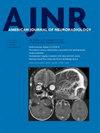Incidence and risk factors of contrast-induced sialadenitis after therapeutic neuroendovascular procedures.
IF 3.7
3区 医学
Q2 CLINICAL NEUROLOGY
引用次数: 0
Abstract
BACKGROUND AND PURPOSE Swelling of the salivary glands, known as contrast-induced sialadenitis (CIS), is an adverse reaction to iodide contrast agents. However, the incidence and risk factors of CIS after therapeutic neuroendovascular procedures have not yet been established. MATERIALS AND METHODS Demographic and procedural factors that may influence the development of CIS were retrospectively analyzed to identify the incidence and risk factors of this condition. A total of 780 patients who underwent therapeutic neuroendovascular procedures between January 1, 2022 and December 31, 2022 were investigated. The risk factors affecting CIS were analyzed using multivariate logistic regression, and the quantitative degree of association between the volume of contrast administered and occurrence of CIS was determined using the receiver operating characteristic (ROC) curve. RESULTS The incidence of CIS after therapeutic neuroendovascular procedures was 4.2%. Multivariate logistic regression analysis showed that female sex (odds ratio [OR] = 4.420, 95% confidence interval [CI]: 1.377-14.190, p = 0.013), volume of contrast administered (OR = 1.007, 95% CI: 1.003-1.101, p < 0.001), and guiding catheter tip located within the external carotid artery (ECA) (OR = 8.701, 95% CI: 3.459-21.885, p < 0.001) were independently associated with CIS occurrence after therapeutic neuroendovascular procedures. The volume of contrast administered had an area under the ROC curve of 0.723 (95% CI:0.635-0.810; p < 0.001), and the optimal cut-off value of the volume of contrast administered was 205 cc (sensitivity: 0.49, specificity: 0.87). CONCLUSIONS We observed CIS in 4.2% of our patients undergoing therapeutic neuroendovascular procedures. This represents a higher incidence than previously reported. Female sex, volume of contrast administered, and guiding catheter tip located within the ECA are associated with CIS incidence. ABBREVIATIONS AUC = area under the ROC curve; BMI = body mass index; CIS = contrast-induced sialadenitis; ECA = external cerebral artery; GFR = glomerular filtration rate; ROC = receiver operating characteristic.治疗性神经内血管手术后造影剂诱发胆囊炎的发生率和风险因素。
背景和目的唾液腺肿胀,即造影剂诱发的唾液腺炎(CIS),是碘化物造影剂的一种不良反应。材料和方法对可能影响 CIS 发生的人口统计学和手术因素进行了回顾性分析,以确定这种情况的发生率和风险因素。共调查了 780 名在 2022 年 1 月 1 日至 2022 年 12 月 31 日期间接受过治疗性神经内血管手术的患者。采用多变量逻辑回归分析了影响CIS的风险因素,并利用接收器操作特征曲线(ROC)确定了造影剂用量与CIS发生率之间的定量关联度。结果:治疗性神经内血管手术后CIS的发生率为4.2%。多变量逻辑回归分析表明,女性性别(几率比[OR] = 4.420,95% 置信区间[CI]:1.377-14.1901.377-14.190, p = 0.013)、造影剂用量(OR = 1.007, 95% CI: 1.003-1.101, p < 0.001)和位于颈外动脉(ECA)内的导引导管尖端(OR = 8.701, 95% CI: 3.459-21.885, p < 0.001)与治疗性神经内血管手术后 CIS 的发生独立相关。造影剂用量的 ROC 曲线下面积为 0.723 (95% CI:0.635-0.810; p < 0.001),造影剂用量的最佳临界值为 205 cc(敏感性:0.49,特异性:0.87)。结论:我们在接受治疗性神经内血管手术的 4.2% 患者中观察到了 CIS,其发生率高于之前的报道。女性性别、造影剂用量和位于 ECA 内的导引导管尖端与 CIS 的发生率有关。
本文章由计算机程序翻译,如有差异,请以英文原文为准。
求助全文
约1分钟内获得全文
求助全文
来源期刊
CiteScore
7.10
自引率
5.70%
发文量
506
审稿时长
2 months
期刊介绍:
The mission of AJNR is to further knowledge in all aspects of neuroimaging, head and neck imaging, and spine imaging for neuroradiologists, radiologists, trainees, scientists, and associated professionals through print and/or electronic publication of quality peer-reviewed articles that lead to the highest standards in patient care, research, and education and to promote discussion of these and other issues through its electronic activities.

 求助内容:
求助内容: 应助结果提醒方式:
应助结果提醒方式:


